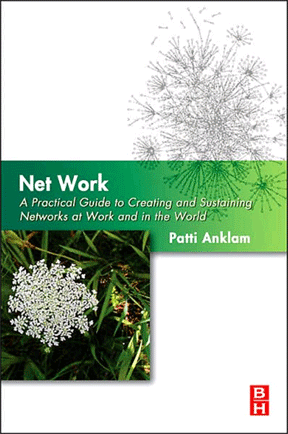 I heard a great talk this morning by Francis Gouillart, who along with Venkat Ramaswamy, authored The Power of Co-Creation: Build It with Them to Boost Growth, Productivity, and Profits
I heard a great talk this morning by Francis Gouillart, who along with Venkat Ramaswamy, authored The Power of Co-Creation: Build It with Them to Boost Growth, Productivity, and Profits![]() . I’ve been hearing the term “co-creation” in a number of contexts, so it was really good to get a real feel for what’s been happening with the concept, and hear real stories about it.
. I’ve been hearing the term “co-creation” in a number of contexts, so it was really good to get a real feel for what’s been happening with the concept, and hear real stories about it.
The concept is not unfamiliar to those of us who were engaged in various forms of process, work, and product design in the early 90s. As Francis talked, I wrote down “participatory design,” and “socio-technical” as those early approaches came to mind as he emphasized the core aspect of co-creation: working with all the constituents in the ecosystem of a product or process to understand their needs and working with them to design the product, process, or system.
He shared a great story about how the French postal service used co-creation as the starting point to address problems of low employee morale and declining revenues. The story illustrated, through increments, some of the principles of co-creation:
- Stakeholder won’t participate in customer co-creation unless it creates value for them. By letting employees determine their own hours, the postal service was able to decrease absenteeism.
- The best way to co-create value is to focus on the experiences of all stakeholders. Once postal employees began talking to customers, they discovered that much of the dissatisfaction with the postal service was because of the restrictions on their hours of service (closed from 12 - 2:00pm for lunch as is French custom) The postal service expanded its hours to match the times that people were normally in town for market (in rural areas) and even until 8pm in cities.
- Stakeholders must be able to interact directly with one another. Bringing customers and postal employees directly into conversation was the path to understanding the customer experience and how to improve it. They had to talk to each other.
- Companies should provide platforms that allow stakeholders to interact and share their experiences. In many cases, platforms these days are interactive (more on this in a later post). But in the case of the postal service, La Poste started having small meetings to coach customers about selling on e-Bay. This had the effect of greater use of e-Bay and (guess what?) more business for La Poste!
(I have taken the principles, bolded above, directly from the HBR article by Gouillart and Ramaswamy on this topic.)
A number of the themes within this concept resonated strongly with me. First and foremost, it’s a network story. I strongly believe, and have articulated many times, that “knowledge is in the network,” and that the future belongs to those who understand how to tap into, and to learn how to weave and leverage strong networks. In the HBR article, the story of how the Indian company ITC transformed their agricultural business in India — and the lives and welfare of the farmers on whom they depend — by creating a network built around e-choupals, internet kiosks spread across the countryside that provided information in local dialects on the daily weather, crop prices, and other news; advice on farming methods; and an email service that let farmers interact directly with scientists.
But the kiosks were only part of the “platform.” The real power in the network came as ITC identified lead farmers to manage the kiosks and create local networks around them. The conversations generated around the e-choupals identified new ways that farmers wanted to interact with ITC, so that ultimately ITC created a network of hub facilities, each of which provided higher-level services to 40 or 50 e-choupals. These networks continue to create value for ITC at the same time that the experiences of the farmers are continually enriched.
The second theme that emerged for me in listening to Francis is how the process relates to, or could leverage value network analysis. (See also here.) Engaging all the stakeholders in understanding the ecosystem is a core part of the VNA methodology. Also critical is that, as the value network mapping process proceeds with stakeholders identifying each of the exchanges (tangible and intangible) that they have with one another, conversations emerge that speak to the quality of those exchanges. In co-creation terms, it’s about the interactions. I sense something a bit different about how the co-creation process goes a level farther (or deeper) than the VNA mapping and it will take me some time to think about how to introduce this into my VNA practice. But the end result is the same: ensuring that every member of the network receives value from the exchanges, and that ultimately the value network itself is creating value as an ecosystem.
I was still a little curious about how co-creation differs from its socio-tech ancestors, but didn’t get a chance to ask the question. Fortunately, @jackvinson was there and he offered the cogent insight that what is truly different is that the leadership that is promoting the process redesign have, in successful cases of co-creation, let go of requiring a specific result. That is (in complexity terms), in the old days management created too many constraints on the outcome whereas they must now be comfortable with setting looser boundaries and letting real value emerge. (I’ve been thinking a lot about the role of leaders and setting boundaries the past few days as well, after recent posts by @snowded and @davegray on self-manged teams, but I’ll save that for another post as well). And, of course, social media has transformed our ability to engage stakeholders in real, ongoing, deeply engaged conversations. What a great new world!



Hi Patti,
Over recent years, it has become increasingly common for the word “co-creation” to be used to describe a deliberate act of collaboration. But I believe that using it in this way obscures a critical aspect of organizational dynamics; that is, that all meanings and outcomes are necessarily co-created.
Co-creation takes place spontaneously. It happens as people perceive, interpret and evaluate things in the natural give-and-take of everyday organizational life - through the conversations that they have with themselves (i.e. thinking) and with others. Importantly, this doesn’t just happen where the formal position is arrived at through deliberate participation and involvement. It applies just as surely in a ‘command and control’ regime.
In short, co-creation is not something that only occurs if a deliberate choice is made to act in a particular way and not in another. It happens continuously and spontaneously, as a natural dynamic of the socially complex nature of all organizations(and all conversations!).
Hi, Chris,
Thanks for commenting. I think I am in agreement with you. I think the notion of co-creation is something that is at the heart of collaboration. WRT this post, it happens that I had been hearing the term “co-creation” pop up in some very specific contexts and was glad to have the opportunity to hear about one of those specific contexts. I think that this work (the book, method) is just an example of using a good concept and deepening it into a method.
Hi Patti,
Greetings from Tokyo. First many thanks for the kind words on the Concord Mafia session and for sharing your reactions to the co-creation concept. On your question about what is different vs. the collaborative development or participatory design approaches, I would say the main difference is probably one of depth of stakeholder involvement in the design of the new interaction, and scale/number of people involved. Any conversation between two open-minded people is by definition co-creative (consulting is a good example), but a consultant typically does not give his/her conversation partner the tools to write his/her own proposal or design his/her own solution. In co-creation, you give the person being “consulted to” the tools to design his/her own solution (e.g., a process. a product design, an IT program, etc.). The other challenge is one of scale. Great consultants are by definition very hard to “scale up”, so the ambition of co-creation is to find an interface that embeds 20-30% of the value of the consultant in the interface tool (the “platform”), but engages a large population in the use of the tool (several thousand people in the case of the French Post Office), therefore bringing a larger transformational impact (albeit less elegantly than a world-class consultant) to the company.